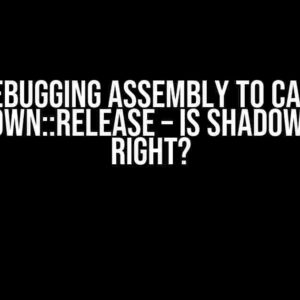Have you ever encountered the dreaded “WebUSB transferIn not a function” error while trying to transfer data from your USB device to your browser? Well, you’re not alone! This issue has been a thorn in the side of many developers, but fear not, dear reader, for we’re about to tackle this problem head-on and emerge victorious.
The Culprit: Understanding WebUSB and TransferIn
Before we dive into the solution, let’s take a step back and understand what WebUSB is and what the transferIn function does.
WebUSB is an API that allows web applications to interact with USB devices. It provides a way for developers to access and control USB devices from their web pages, making it a powerful tool for building innovative applications.
TransferIn is a method of the WebUSB interface that allows you to read data from a USB device. It takes a single argument, the endpoint number, and returns a promise that resolves with the received data.
The Error: WebUSB transferIn not a function
So, what happens when you encounter the “WebUSB transferIn not a function” error? It usually occurs when your web application tries to call the transferIn method on an invalid or uninitialized WebUSB interface.
This error can be frustrating, but don’t worry, we’ve got you covered. In this article, we’ll explore the common causes of this error and provide step-by-step instructions to fix it.
Common Causes of the Error
Before we dive into the solutions, let’s identify the common causes of the “WebUSB transferIn not a function” error:
- Invalid or missing USB device permissions
- Incorrect WebUSB interface initialization
- USB device not connected or not properly configured
- Outdated or incompatible browser versions
- Incorrect endpoint number or configuration
Fixin’ Time!
Now that we’ve identified the common causes, let’s get to fixing the issue! Follow these steps to resolve the “WebUSB transferIn not a function” error:
Step 1: Check USB Device Permissions
Make sure your web application has the necessary permissions to access the USB device. Add the following code to your HTML file:
<script>
navigator.permissions.query('usb').then(permission => {
if (permission.state === 'denied') {
// Handle permission denied
} else {
// Initialize WebUSB interface
}
});
</script>
Step 2: Initialize WebUSB Interface Correctly
Ensure you’re initializing the WebUSB interface correctly by following these steps:
- Check if the browser supports WebUSB:
- Request access to the USB device:
- Claim the interface and set the endpoint:
<script>
if (!('usb' in navigator)) {
// WebUSB not supported
}
</script>
<script>
navigator.usb.requestDevice({ filters: [{ vendorId: 0x1234, productId: 0x5678 }] }).then(device => {
// Initialize WebUSB interface
});
</script>
<script>
device.open().then(() => {
device.claimInterface(0).then(() => {
const endpoint = device.endpoint(1); // Replace with your endpoint number
// Set the endpoint configuration
});
});
</script>
Step 3: Verify USB Device Connection and Configuration
Double-check that your USB device is properly connected and configured:
- Verify the USB device is connected to the computer
- Check the device is properly configured and recognized by the operating system
- Ensure the USB device is not in use by another application
Step 4: Update Browser Version (If Necessary)
If you’re using an outdated browser version, update to the latest version to ensure WebUSB support:
<p>Check your browser version and update to the latest version if necessary.</p>
Step 5: Verify Endpoint Number and Configuration
Make sure you’re using the correct endpoint number and configuration:
<code>
const endpointNumber = 1; // Replace with your endpoint number
const endpointConfiguration = { packetSize: 64 }; // Replace with your endpoint configuration
</code>
Putting it all Together
Now that we’ve covered the common causes and solutions, let’s put it all together in a working example:
<script>
// Check USB device permissions
navigator.permissions.query('usb').then(permission => {
if (permission.state === 'denied') {
// Handle permission denied
} else {
// Initialize WebUSB interface
navigator.usb.requestDevice({ filters: [{ vendorId: 0x1234, productId: 0x5678 }] }).then(device => {
device.open().then(() => {
device.claimInterface(0).then(() => {
const endpointNumber = 1;
const endpoint = device.endpoint(endpointNumber);
endpoint.configuration = { packetSize: 64 };
// Call transferIn method
endpoint.transferIn(64).then(data => {
console.log('Received data:', data);
}).catch(error => {
console.error('Error:', error);
});
});
});
});
}
});
</script>
Conclusion
In this article, we’ve tackled the dreaded “WebUSB transferIn not a function” error, identifying common causes and providing step-by-step solutions to fix it. By following these instructions, you should be able to resolve the issue and successfully transfer data from your USB device to your browser using WebUSB.
Remember to double-check your code, USB device permissions, and endpoint configuration to ensure a smooth and error-free experience. Happy coding!
| Troubleshooting Tips |
|---|
|
Still stuck? Leave a comment below, and we’ll do our best to help you out!
Frequently Asked Question
Get answers to your most pressing WebUSB transferIn not a function questions!
What does “WebUSB transferIn not a function” even mean?
Don’t worry, it’s not as cryptic as it sounds! “WebUSB transferIn not a function” is an error message that usually appears when your browser is trying to communicate with a USB device, but the device doesn’t support the transferIn function. This function is used to read data from the device, so if it’s not available, your browser can’t complete the task.
Why is WebUSB transferIn not working for my device?
There are a few reasons why WebUSB transferIn might not be working for your device. First, make sure your device is compatible with WebUSB. Next, check if the device is properly connected and configured. Finally, verify that the device’s firmware supports the transferIn function. If none of these solutions work, try updating your device’s drivers or firmware.
Is WebUSB transferIn supported by all browsers?
Unfortunately, not all browsers support WebUSB transferIn. Currently, only Google Chrome and Microsoft Edge have implemented this feature. If you’re using a different browser, you might need to switch to a compatible one or use a different method to interact with your USB device.
Can I use WebUSB transferIn with any USB device?
Not exactly. WebUSB transferIn is designed to work with USB devices that support the USB Device Class Specification. This means that not all USB devices are compatible with WebUSB transferIn. Additionally, some devices might require specific drivers or software to function properly.
How do I enable WebUSB transferIn for my USB device?
To enable WebUSB transferIn for your USB device, you’ll need to follow these steps: First, check if your device supports WebUSB and transferIn. Next, ensure that your device is properly connected and configured. Finally, use a compatible browser and the WebUSB API to interact with your device. You might also need to obtain the necessary permissions and configure your browser’s settings.



